|
CALIFORNIA'S ELECTRICITY OPTIONS AND
CHALLENGES
REPORT TO
GOVERNOR GRAY DAVIS
Michael Kahn
Chairman
Electricity Oversight Board
Loretta Lynch
President
California Public Utilities Commission
I.
California's Electric System: Where We Are and How We Got Here
|
California's electric system is in trouble. To understand why, we
need to know how it operates and how comprehensive changes in the l990s affected its
operation.
1. The Electric System in California Is Interconnected
The State's electric system has three major components:
·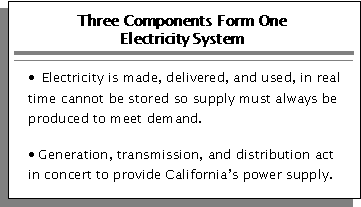 Generation - Generation refers to the production of electricity at power plants or other
facilities. California has about 1,000 generation facilities with 55,500 MW of capacity,
including those run by gas and oil, nuclear power, hydro, biomass, wind, solar and
cogeneration.1 The State
is able to import an additional 8,000 MW and, of these, about 4,500 MW are under contract
as "firm" supplies.2
Generation - Generation refers to the production of electricity at power plants or other
facilities. California has about 1,000 generation facilities with 55,500 MW of capacity,
including those run by gas and oil, nuclear power, hydro, biomass, wind, solar and
cogeneration.1 The State
is able to import an additional 8,000 MW and, of these, about 4,500 MW are under contract
as "firm" supplies.2
· Transmission - the wires that run from generators to carry power
throughout the State to distribution facilities. California has about 40,000 miles of
power lines that connect utilities to the national and international electric power grid.
· Distribution - the wires and related facilities that run from
customer premises to transmission substations (the sites where high voltage power is
stepped down so that it can be delivered to customers on the distribution system) ;
The system's components are highly interrelated, economically and
operationally. California can relieve supply problems by constructing new generation
plants or transmission facilities. Transmission facilities are a key element of the
structure, because they tie together the large power plants, often in remote locations, to
the load centers where electricity is consumed. In a competitive system, the ability of
generation sellers and generation buyers to interact is mediated by the transmission
system.
If transmission transfer capacity is inadequate, the ability of
loads to get imported power is reduced, and the ability of local generators to raise
prices through the exercise of their market power is enhanced. California has a
demonstrated need for transmission upgrades for both reasons.
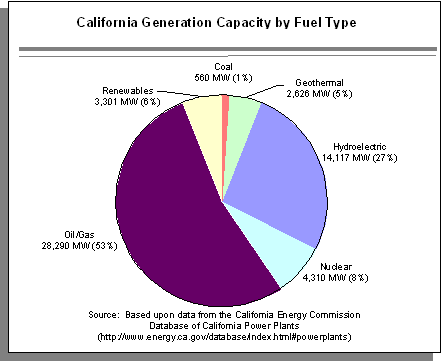
As the chart to the right shows, California's electricity comes from
many different sources, some more costly than others, and some cleaner.
2. Regulation of California's Electric System Is
No Longer Integrated
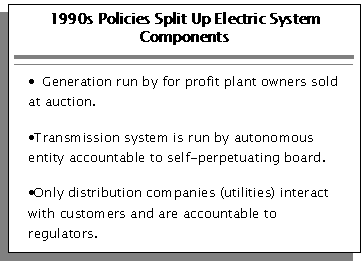 Historically,
California utilities owned and operated all elements of the State's electric system. The
PUC regulated the entire system3of
utility generation, distribution and transmission through its control of retail rates. The
PUC also regulated service reliability, utilities' dealings with their customers, and the
availability of different types of electric service. The PUC was responsible for - and had
the tools to police -- the utilities' service to consumers. FERC regulated wholesale
transmission rates and power transactions between utilities and between utilities and
generators. But because utilities owned most power plants, and sold power directly to the
customer, FERC did not set California power rates. Historically, the PUC and the FERC had
a complementary role in setting wholesale rates for non-utility power producers, called
"qualifying facilities." Historically,
California utilities owned and operated all elements of the State's electric system. The
PUC regulated the entire system3of
utility generation, distribution and transmission through its control of retail rates. The
PUC also regulated service reliability, utilities' dealings with their customers, and the
availability of different types of electric service. The PUC was responsible for - and had
the tools to police -- the utilities' service to consumers. FERC regulated wholesale
transmission rates and power transactions between utilities and between utilities and
generators. But because utilities owned most power plants, and sold power directly to the
customer, FERC did not set California power rates. Historically, the PUC and the FERC had
a complementary role in setting wholesale rates for non-utility power producers, called
"qualifying facilities."
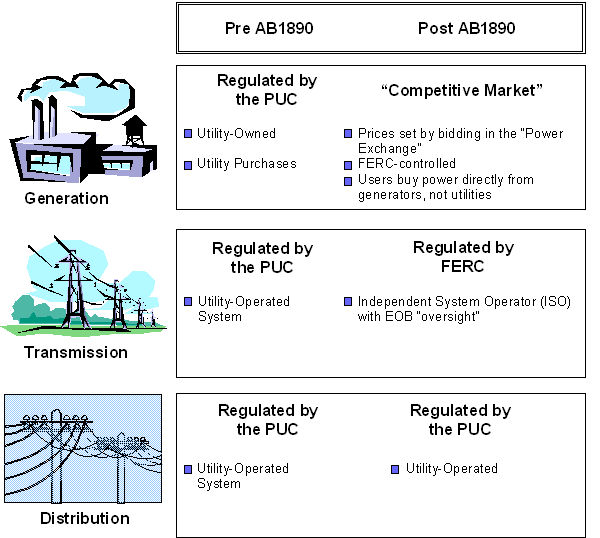 For
more than fifty years before 1996, the structure of the California electricity industry
changed little. Investor-owned utilities owned and operated power plants and wires, and
they charged retail electricity rates as set by the PUC. As the chart below shows, the
vast majority of power used in California was produced either by a for-profit or municipal
utility, both regulated by public entities. Transactions between utilities and with other
States were overseen by the FERC. Both the PUC and the FERC were required by law to set
"just and reasonable" rates. They did so by basing rates on demonstrated costs
and acting as a brake on price run-ups. But in the early 1990's rising retail prices and a
philosophical shift away from cost-of-service regulation and toward competition led to
calls for reform. For
more than fifty years before 1996, the structure of the California electricity industry
changed little. Investor-owned utilities owned and operated power plants and wires, and
they charged retail electricity rates as set by the PUC. As the chart below shows, the
vast majority of power used in California was produced either by a for-profit or municipal
utility, both regulated by public entities. Transactions between utilities and with other
States were overseen by the FERC. Both the PUC and the FERC were required by law to set
"just and reasonable" rates. They did so by basing rates on demonstrated costs
and acting as a brake on price run-ups. But in the early 1990's rising retail prices and a
philosophical shift away from cost-of-service regulation and toward competition led to
calls for reform.
· Before the 1980s. Investor-owned utilities planned, built,
owned, and operated distribution, transmission, and power plants under PUC supervision.
Prices for energy were set according to the costs of running power plants, and these costs
were scrutinized by the PUC to ensure reasonable prices. Utilities were held accountable
for reliability by the PUC and the public, and utilities had strong incentives to plan and
operate their power plants and other facilities to give highly reliable service. During
this period, the utilities pursued investments in large power plants and nuclear
facilities.
· The 1980s. In the l980s, utilities also administered
energy efficiency and conservation programs using ratepayer funds under PUC supervision.
State energy planners and regulators balanced supply and demand through Integrated
Resource Planning, building new power plants when needed but investing in conservation and
energy efficiency to minimize the need for costly new plants. By this time, nuclear plants
were built and running, and the cost of producing that power increased utility rates. Late
in the decade, utility rates were driven up further by higher fuel prices and policies
that encouraged QFs to build new private, non-utility power plants.
As the chart to the right shows, 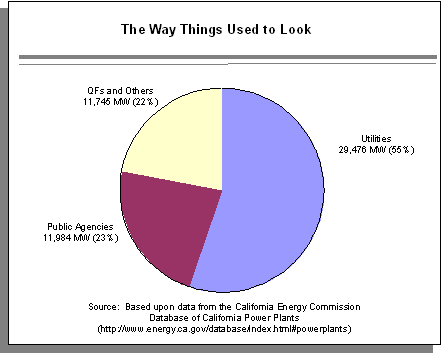
during this period power plants were largely owned by utilities or
public agencies, and their rates were overseen by state or local government.
· The Early l990s. In the early 1990s, the PUC's and past
administrations' commitment to integrated resource planning waned. The PUC's policy
increasingly emphasized competitive provision of power. It used a bidding process4to choose new power plants to
meet projected demand, but little or no new capacity was actually built before that
process was superseded by the mid-90s, policy shift away from cost-of-service regulation
and toward reliance on pure market forces. The chart on the following page shows who owns
power plants in California now.
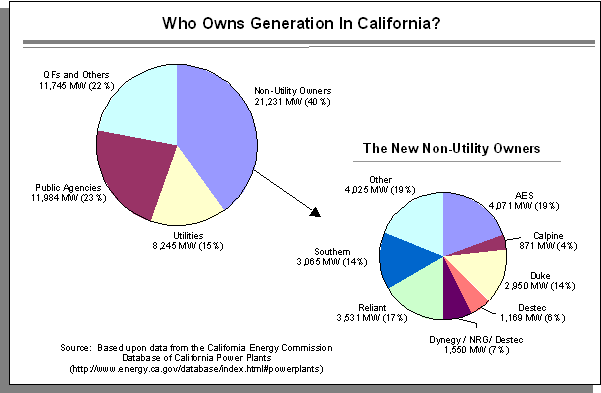
In 1994, the PUC recommended fundamental structural reform that
would move substantial regulatory authority to the federal government. In l995, the PUC
made official its commitment to competitive market models when it issued an order
directing the utilities to "unbundle" their integrated systems5and in l996, AB 18906 responded to and shaped the
actions already underway at the PUC.
In sum, the PUC direction, as shaped by AB 1890:
· Transferred pricing of California's electricity generation to the
FERC by creating the California Power Exchange, a private nonprofit organization which
would set wholesale sales of electricity;
· Created incentives for utilities to sell their generation
facilities to unregulated private power companies;
· Transferred operational control of the utility-owned transmission
system to the ISO, a private nonprofit organization which would manage the transmission
system and its day-to-day operations under FERC oversight;
· Let the utilities retain ownership and control of the
distribution system;
· Set rates in a way that accelerated payoffs of the capital costs
of utility power plants by permitting the utilities to "freeze" artificially
high rates and use revenues exceeding costs to pay down capital investment. The amount
used for this purpose is listed as a "CTC"7charge on every Californian's
electric bill.
· Provided that the rate freeze would end when the capital costs of
utility generation assets have been recovered or at the end of a 2001, whichever occurs
first. The rate freeze ended for SDG&E in mid-19998 it remains in place for
PG&E and Edison.
Every constituency group endorsed AB 1890, except one consumer group
that took no position. California lawmakers and their constituencies were optimistic that
the new model would bring prices down and assure safe, reliable power.
3. Purchases and Sales of Power Under the New Structure
The new system of buying and selling power, and the rules that
govern those sales and purchases, is extraordinarily complex. Simply stated, a day in
advance, participating generators bid power into the wholesale market auction, conducted
by the PX and their counterpart buyers, estimate and order the power needed to meet
California's electricity demands. On the basis of hourly supply and demand bids and
orders, the PX sets the price to be paid to all power sellers at the highest amount bid
for that hour, even if some sellers would have sold power at a lower price. The ISO then
directs the flow of electricity throughout the State. When supply purchased in the PX
market is less than the State's demand for electricity, the ISO makes up the difference by
purchasing enough electricity to balance the load and meet specified "reserve"
levels.

The Independent System Operator administers a graduated system of
increasing alerts to maintain operating reserves - the buffer capacity needed at all times
to keep the electric system stable and functioning. When forecasted reserves for the next
day fall below 7%, the ISO issues an Alert, and generators are asked to increase their
power bids into the market. When forecasted reserves for the current day fall below 7%,
the ISO issues a Warning, and the ISO begins buying supplies directly. When actual
reserves fall below 7%, then 5%, then 1.5% the ISO issues first a Stage 1 Emergency
(public appeals and other measures to increase supply and decrease demand), then a Stage 2
Emergency, (interruptible customers are curtailed), and finally a Stage 3 Emergency, the
highest level, under which firm customers (including residential and commercial) are
blacked out to keep the system from crashing.
The ISO purchases "ancillary services" - generation
products needed to enable it to instantaneously balance load by ramping generators up and
down - that include both the capacity to produce electricity, and the actual production.
There are a number of "auctions" for ancillary services into which generators
can bid under current rules; in addition, schedule coordinators (SCs) can adjust their
schedules to enable the ISO to balance the system. In addition, the ISO has signed long
term "reliability- must-run" contracts with some generators whose power is used
to keep the transmission system stabilized. These R-M-R contracts provide a degree of
control comparable to the former utility integrated ownership.
The ISO limits the top price purchasers will be charged for
electricity with "price caps" approved by the FERC through the tariff process.
Wholesale price caps limit the market's ability to drive prices up during periods of short
supply. The use of price caps recognizes the potential for sellers' market power or
customers' inelastic demand to drive up prices.
Currently, the law requires that California electric utilities,
which serve the vast majority of California customers, purchase all of their power through
the ISO and the PX. However, individual (usually large) customers and marketers may
purchase power outside the PX by signing "bilateral" contracts with marketers or
generators. The ISO's centralized system still directs the flow of electricity, but prices
and service conditions are established by private contract.
4. California in the National Context
California was the first state in the nation to create a separate
independent system operator - the ISO - to control utility-owned transmission facilities.
California moved first and furthest in divesting the utilities of their power plants. It
created an exchange - the PX - to run wholesale power auctions and shape wholesale power
products, like futures. The separation of the power sales function and the transmission
control system function into two separate organizations is a distinguishing characteristic
of California's experiment. The separation of these functions also complicates the
operation of California's wholesale electricity market.
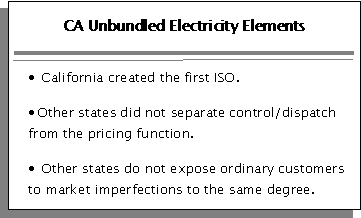
Several other states have followed California in designing their
electricity industries with ISOs that are regulated not by State or local authorities, but
by the FERC. However, California is the only state with an ISO comprised of stakeholders
rather than an ISO that is a public agency.
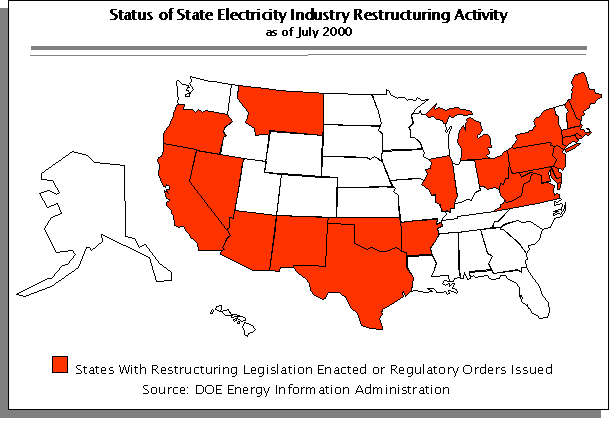 Twenty-five
states have not yet restructured their electric industries, apparently awaiting the
results of changes in California and Northeastern States. In addition, municipal utilities
in California have been cautious to join the new statewide system. Although they have
coordinated some of their system operations with the ISO, the PX and the State's other
utilities, municipal power companies have retained their power plants and control of their
transmission systems. This control has protected customers of municipal utilities-like the
Los Angeles Department of Water and Power-from the price shocks and supply shortages that
have occurred in other parts of the State this summer. Twenty-five
states have not yet restructured their electric industries, apparently awaiting the
results of changes in California and Northeastern States. In addition, municipal utilities
in California have been cautious to join the new statewide system. Although they have
coordinated some of their system operations with the ISO, the PX and the State's other
utilities, municipal power companies have retained their power plants and control of their
transmission systems. This control has protected customers of municipal utilities-like the
Los Angeles Department of Water and Power-from the price shocks and supply shortages that
have occurred in other parts of the State this summer.
California's choice of restructuring plans has made a difference in
California prices and supply conditions, even though California is part of a tightly
interconnected grid that courses through several states in the Western Region. California
participates in the Western Systems Coordinating Council, a voluntary organization that
coordinates the activities of the "control areas" that make up the grid. The
WSCC establishes reliability standards, such as operating reserve requirements, that
protect the larger system for all interconnected participants.
The California ISO is the largest control area. It buys and sells
enormous quantities of electricity, dispatching power from plants and operating the
California transmission system. Unlike the other utilities that participate in the WSCC,
the ISO is neither a governmental body nor a state-regulated utility. The California ISO
has no responsibility to California consumers. Indeed, it seeks to control the
transmission system in several states as a regional operation.
Conclusions
Over the past twenty years California has transformed its electric
system from one that was integrated and highly regulated to one that is unbundled and
increasingly subject to competitive markets and federal oversight. Although the state
retains regulatory control over utility distribution systems, the FERC regulates the
transmission system operations and transmission rates. The FERC also regulates the terms
and conditions of most power trades in California because most are now wholesale
transactions rather than retail transactions which would be subject to state regulatory
oversight. In addition, power sales and transmission are controlled mainly by two private,
nonprofit organizations that have no duty to serve California's public.
Under California's new system, California power purchasers so far
this summer have paid much more for power than in the past and the system has been more
vulnerable to supply shortages than ever before.
II.
The Lessons of Spring 2000
|
The events giving rise to this Report started with ISO calls for
widespread interruption of industrial and other large customers on May 22, 2000, and the
imposition of rolling blackouts in the Bay Area on June 14, 2000. Beginning in May 2000,
costs for power in all regions and economic sectors of California increased by billions of
dollars. On several days in the second quarter of the year, reliability was significantly
compromised. The appearance that reliability has been compromised makes all the more
distressing the huge run-up in prices - Californians are paying a lot more for a lot less,
in terms of service.
1. Coordination Problems Occurred in May, Triggering
Unnecessary Power Interruptions.
On May 22, 2000, the weather was hot in Northern California. The ISO
anticipated an electricity shortage and declared a Stage 2 emergency at 11:40 a.m. It
called for utilities to curtail service to several hundred large customers.9 A Stage 2 emergency
means that operating reserves are less than 5% of expected load; curtailment means that
some customers, must reduce their consumption and shut down operations if necessary. These
customers who are paid in advance for this responded promptly. Some sent their employees
home. But it very quickly developed that the ISO had made a calculation error, losing
track of approximately 1500 MW10of available power, and leaving that power out of its
calculation.
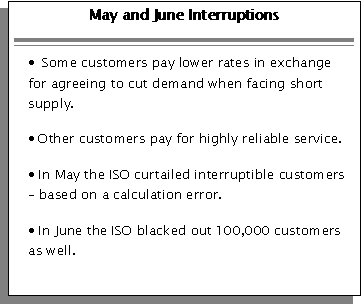
On June 14, PG&E was required to intentionally interrupt nearly
100,000 customers (residential and small business) for the first time in its history. This
remarkable event was not related to insufficient supply in the ISO control area as a
whole. Rather, it was related to grid instability in the Bay area. The transmission grid
operates at a load level of 230,000 volts, with small deviations. If supply and demand get
too far out of balance, the entire system can crash, possibly spreading throughout the
interconnected grid in the West.
The Bay area grid instability was related to high loads and short
supplies in that area, which could not be relieved given the design of the transmission
system. It was exacerbated by the fact that the evening before, instability was created by
generator decisions to generate energy without notifying the ISO Generators created these
deviations in order to be paid a higher price within the ISO Control Area, and these
deviations caused less than optimal voltage stability on its system.11 The ISO became aware of
this instability on June 13; the stage was set for the following day.
On June 14 the Bay Area suffered unusually hot weather for June,
with San Francisco peaking at 103 degrees. Hot weather contributed directly to a
record-setting peak load for June of 43,300 MW, system wide. PG&E peaked at 23,361 MW12 not counting the
customers interrupted.
On June 14, import capacity on the transmission system was limited,
in order to keep the voltage levels on the grid stable. These import limitations reflected
both technical constraints in Northern California and events outside the state. The loss
of generation in the Northwest and work being done by Bonneville Power Administration on
the British Columbia Hydroelectric Tie limited California's ability to import power.
Voltage instability related to gaming on the previous day, import
limitations, power plants out, and record temperatures set the stage for disaster on June
14, 2000. At 7:30 a.m. the ISO announced that it would request PG&E to curtail 500 MW
of interruptible customers beginning at 1200 hours to help correct voltage problems.
Reactive support at the transmission and distribution levels was also required of PG&E
and the municipalities (Silicon Valley Power, Northern California Power Agency (NCPA),
Alameda and Palo Alto).
The critical point below which a system crash becomes imminent is
225,000 volts. Late in the morning, the ISO determined that firm load dropping was
imminent and requested PG&E to man all substations. In order to avoid a voltage crash
in the Bay Area, the Newark Substation had to maintain a voltage of 228 kV. At 1313 hours,
the Newark Substation dropped to 227,000 volts and headed toward 226,000 volts. This
triggered the ISO's request for firm load shedding by PG&E. The following blocks were
shed:
Block
Number |
Duration of
Outage |
Number of Customers13 |
Number of MW |
1A |
1313 to 1435 |
33,763 |
143.9 |
1B |
1430 to 1535 |
17,616 |
132.1 |
1D |
1530 to 1635 |
9,586 |
29.4 |
2A |
1530 to 1635 |
36,064 |
115.5 |
Total |
1313 to 1635 |
97,029 |
420.9 |
Once Block 1A14was shed, by contract NCPA shed 3 MW at Palo Alto and 1 MW
at Alameda. In a cooperative action, Silicon Valley Power offered to interrupt its
non-firm customers, totaling 5 MW beginning at 1400 hours. In order to reduce further
curtailments, the ISO loaded key 500/230 kV transformers and transmission lines either
near or exceeding their ratings. The firm load shed caused voltage levels to stabilize and
averted a wider event.
The ISO issued a Stage 1 Emergency Notice throughout its system, due
to a projected operating reserve of 5.3 percent beginning at 1:00 p.m., remaining in
effect until 2000 hours. All firm load was restored by 4:35 p.m. with interruptible load
restored at 6 p.m.
2. Retail Prices for Electricity Increased Substantially
In the week, of June 11-15, purchasers of California power spent
over $1 billion to buy electricity, one eighth of their spending for all of 1999.15 The effects of these
price increases on customers depend on their choice of electricity supplies. Retail
customers of Pacific Gas and Electric Company (PG&E) and Southern California Edison
Company (Edison) are temporarily protected from the impact of rate spikes caused by direct
exposure to high wholesale prices. Customers of municipal utilities may face higher
prices, unless their governing bodies have deferred rate increases. Retail customers of
non-utility electricity marketers, including renewable energy customers who have opted for
direct access, may also have higher bills if their electricity rate is set as some
percentage of the "PX price." Anecdotal evidence suggests that this is the case.
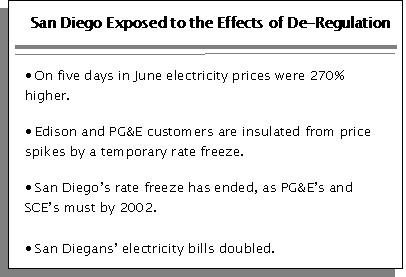
Because SDG&E is no longer subject to a retail price freeze, its
customers' electric bills for June service more than doubled, as the chart below
illustrates. The portion of retail customers' bills that goes to pay for electricity16increased almost 300%
(from roughly 5 cents to 15 cents). As a result, SDG&E's total rates for June are
twice the national average for residential consumers. The charts below compare residential
rates and residential bills for SDG&E, PG&E and Edison over the past decade.
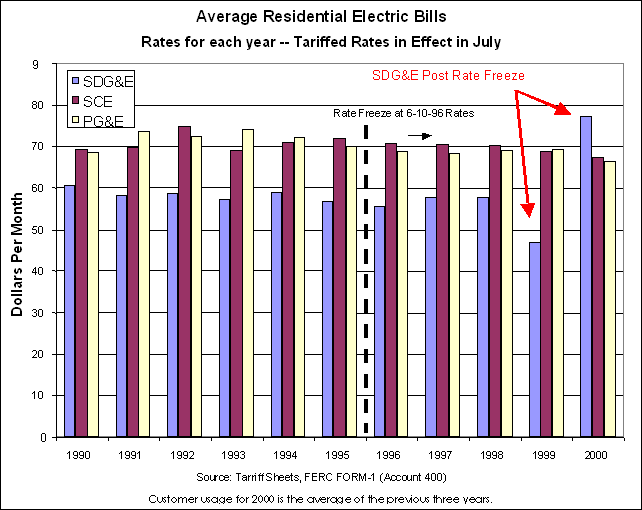
The rise in bills experienced in San Diego prefigure rises that will
eventually come to other California customers. The high residential electricity rates
demonstrated in the chart below will hit other customers unless something is done.
Currently, SDG&E may "levelize" its retail customers'
liability for these wholesale electricity costs by spreading out the high electricity
payments over a future period, pursuant to PUC authorization. Generally, however, the PUC
is limited in what it can do to relieve customers' liability for these wholesale costs.
The federal "filed rate doctrine" requires States to pass through to utility
customers the costs of electricity that are purchased subject to federal tariffs.17 SDG&E's purchases
from the ISO and PX are federally tariffed. Thus, the FERC ultimately controls how much
SDG&E pays for wholesale power. Whatever SDG&E pays for wholesale power, if
allowed under a federal tariff, must by federal mandate be passed through to San Diego
utility customers. The PUC may, however, inquire whether SDG&E's purchasing strategies
were reasonable and resulted in reasonable rates. The PUC may exclude from retail rates
recovery of costs determined to have been imprudently incurred.
The San Diego price spikes, impose particular burdens on fixed and
low-income customers. The PUC sets a discounted rate for low-income customers by statute.
Currently, the PUC requires that all utilities offer a 15% discount for low-income
customers under the "CARE" program.18 This discount is clearly not a complete solution for
customers whose bills have recently doubled.
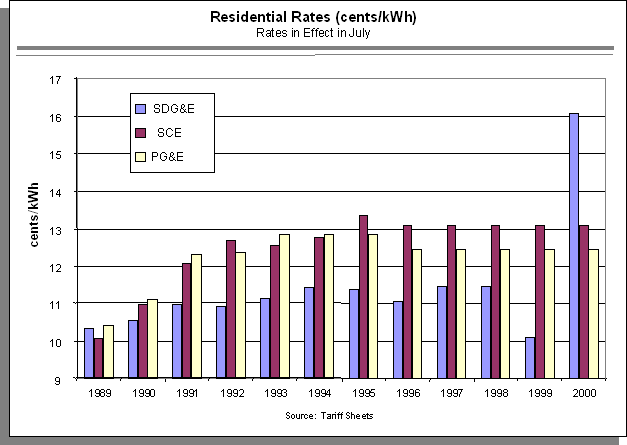
3. Wholesale Prices Increased Substantially
This summer's high electricity bills result from increased wholesale
prices. Wholesale prices for May and June 2000 are many times higher than for May and June
1999. 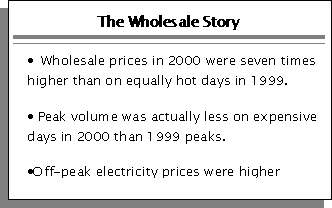
The price increase is not explainable by increased costs, weather,
volumes or even the existence of a much higher wholesale price cap, in 2000. A comparison
of June 29, 1999 to June 29, 2000, both relatively hot weekdays, illustrates the magnitude
of the run-up in wholesale prices. Peak loads on the ISO system were comparable: 40,443
megawatts at 4 p.m. in 1999; 41,606 at 4 p.m. in 2000, a difference of less than 3
percent. Sales volumes in the PX day ahead market were also comparable, but prices in the
day ahead market were much higher in 2000. A comparison of average prices illustrates the
price difference.19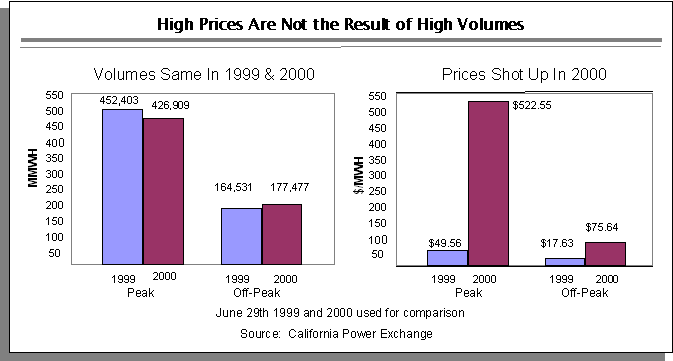
A comparison of hourly loads reveals more.20 On both days,
substantial load was supplied through the ISO-controlled real-time markets, 146,000 MWH in
1999 versus 191,000 in 2000. However, during the peak hours between 12 and 6 p.m., 3000
fewer megawatts were supplied through the day ahead market in 2000 than in 1999. This
suggests sellers may have been withholding power from this market in order to drive up
prices in other parallel markets. The ISO has adopted a policy of making premium payments
for "replacement reserve" which can be called upon when supplies are short. On
June 29, 2000, nearly 10 percent of load was supplied through real time markets at
"replacement reserve" prices that were 50 percent higher than the
astronomical prices above. The ISO has refused to provide us with the data necessary to
determine what really happened.
On both days, prices in real time markets reached the current price
cap -- $250 per megawatt in 1999 and $750 in 2000. Had the 1999 price cap of $250 been in
effect in 2000, Californians might well have saved at least $110 million on that day
alone. On August 1st, after Governor Davis requested action, the ISO voted to
reinstate the 1999 $250 price cap, effective August 7th. This reduction to last
year's levels will have some moderating effect on retail prices in the coming months.
However, if the ISO continues to purchase substantial replacement reserves at uncapped
prices, purchasers of California power will still be forced to pay higher prices.
Total energy usage on June 29, 1999 was 763,000 megawatt hours, at a
cost of approximately $45 million dollars. On June 29, 2000, Californians used 795,000
megawatt hours, that cost them over $340 million.
Warm weather alone does not explain the magnitude of the enormous
run-up in wholesale prices. Wholesale electricity costs were seven times the previous
year's on days when loads were comparable. Further, as the chart below shows, the highest
loads for 2000 were consistently well below 1999 peak loads.
| |
|
|
|
Weekly
ISO Peaks, May-June 2000
With 1999 Peak and Forecasted Peak for 2000 |
Week Ending |
Peak Day |
Low for the week
(MW) |
High for the week
(MW) |
| May 6, 2000 |
May 2, 2000 |
18,983 |
33,148 |
| May 13, 2000 |
May 12, 2000 |
18,762 |
31,287 |
| May 20, 2000 |
May 19, 2000 |
18,140 |
34,375 |
| May 27, 2000 |
May 22, 2000 |
20,041 |
39,521 |
| June 2, 2000 |
June 1, 2000 |
19,910 |
36,137 |
| June 9, 2000 |
June 6, 2000 |
19,502 |
35,417 |
| June 16, 2000 |
June 14, 2000 |
19,065 |
43,447 |
| June 23, 2000 |
June 21, 2000 |
20,482 |
41,414 |
| June 30, 2000 |
June 27, 2000 |
18,302 |
42,693 |
| |
|
|
|
| July 17, 1999 |
July 12, 1999 |
20,710 |
45,574 |
| |
|
|
|
| Source: California Independent
System Operator, Load comparison summaries, July 1999, May and June 2000, Press release
dated May 10, 2000. |
California normally experiences similar weather conditions for
extended periods in later summer months. Yet never before during a heat wave have
purchasers paid the prices for California power that they have paid this summer.
Moreover, higher wholesale prices this spring cannot be explained by
higher wholesale prices for natural gas, which fuels most California power plants. Indeed,
gas prices have almost doubled over the past year. However, wholesale prices for power in
June 2000 have increased as much as tenfold over last year even during periods when demand
was no higher than during comparable periods in June 1999. Even off-peak prices in June
2000 are more than four times their level in June 1999. Even if natural gas comprised 100%
of power plant operating costs, the increase in natural gas prices would not explain the
higher wholesale prices in California in June 2000.
The unprecedented price levels of June 2000 may have had one
predictable result. Many energy companies, including some participants in the California
market, made very high profits during the second quarter. Detailed financial information
recently reported by power plant owners is contained in Attachment 2. Although it is
difficult to isolate the financial results from California operations, power plant
operators are reporting extraordinary profits for the summer. One company that purchased
1354 MW of power generating capacity from the utilities reported a 176% profit increase
for the quarter ending June 30.
Although these businesses also produce other products than
electricity and sell them in other markets than California, such high profits suggest that
this group of companies benefited substantially from the summer's unprecedented wholesale
electricity price run-up in California. As a PG&E Vice President recently explained
"If you've got the only Beanie Babies in town, you can charge whatever you want....Is
that (price) gouging? I don't know."21
The Federal Power Act requires that electric rates be "just and
reasonable." Traditionally this has meant "cost based" rates in which
investments in new or refurbished power plants were amortized over a long period of time,
and profits were set at a reasonable level. Under the new market structure, wholesale
prices for electricity are not necessarily based on costs. The FERC now permits power
plant owners to sell wholesale power at "market-based rates," with very little
evidence to support those rates as just and reasonable. It appears that the FERC's
assumption-that the market will discipline wholesale prices-is not a reasonable one at
this time in California.
While the profits of unregulated California power plant owners rise,
the summer's wholesale price spikes are putting PG&E and Edison at risk. California's
utilities must buy high priced electricity in California wholesale markets, but under the
mandated rate freeze, they cannot raise the retail rates they charge customers. Because
they are still subject to the rate freeze imposed by AB 1890, PG&E and Edison must
bear the power costs that exceed their revenues.
PG&E and Edison incur these costs when they buy power from the
PX on behalf of their customers. Under the terms of AB 1890, PG&E and Edison could
potentially be liable for billions of dollars in excess generation costs. The extent to
which Edison or PG&E will ultimately have to bear those costs will depend on the
future prices of wholesale power, and net costs when balanced against the wholesale
profits received as a power producer (for power from, for example, their nuclear
generating units, Diablo Canyon and SONGS).
FERC-authorized price caps imposed by the ISO have limited wholesale
prices so far. On August 1, 2000, the ISO reduced the price cap from $500 to $250 per
megawatt. However, the ISO's authority to impose price caps expires on October 31, 2000,
absent a FERC extension. Without wholesale price caps, future wholesale electricity prices
will almost surely continue to increase in the next several years.
4. Did Electricity Sellers or Electricity Buyers Game the
System?
Properly functioning electricity markets involve producers and
consumers voluntarily selling and buying at mutually acceptable prices. Electricity is
essential to the public welfare. Protecting the public interest requires that electricity
be delivered at an acceptable price, electricity cannot be given up if the price becomes
too high. Because the purchase is not discretionary, market theories of willing sellers
and buyers with alternatives do not apply.
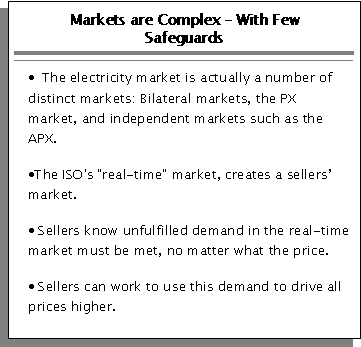 The California "electricity market" actually consists of a number of
segmented and overlapping markets. In some of the markets traditional supply and demand
dynamics may apply. However, in the last and ultimate market - the real time market
conducted by the ISO, buyers have no alternatives. All demand must be met.
The California "electricity market" actually consists of a number of
segmented and overlapping markets. In some of the markets traditional supply and demand
dynamics may apply. However, in the last and ultimate market - the real time market
conducted by the ISO, buyers have no alternatives. All demand must be met.
The ISO is obliged to ensure that all demand is met, and also to
provide for adequate reserve support, including "replacement reserves". There is
no other option in the real-time market. Even the other markets, - the California Power
Exchange, the Automated Power Exchange, and the bilateral markets, - are affected by the
ISO's activities. When supply becomes tight in relation to anticipated demand, prices in
all markets increase, in part because of the knowledge that unfilled demand in the final
real-time market must be met - even if it is met at a very high price. This knowledge may
induce sellers to withhold supply in order to raise prices in all markets. Withholding can
be accomplished in very sophisticated ways.
The combination of a flawed market structure and lack of investment
in new generation over an extended period of time now exposes Californians to shortages
and high prices. The ISO is a captive-as the buyer of last resort, it cannot refuse to buy
at premium prices. Even worse, the ISO cannot reduce its price exposure through financial
instruments or long term contracts. In addition, the largest consumers - the utility
distribution companies - have only limited authority to reduce their own exposure.
Where generation sellers also control transmission, they may have an
unfair advantage, viewed from the perspective of competitors. Adopting the competitors'
perspective, FERC has required "unbundling" of the transmission grid, so that
combined control of generation and transmission cannot be the basis for undue
discrimination in favor of the transmission owner's generation, even if that generation is
dedicated to serving the generator's own retail customers.22
On a number of days in June 2000, electricity demand was high. Being
well-informed about market conditions, power-plant owners were able to bid high selling
prices with the near certainty of selling power on those days. The owners' bids did not
correspond to their variable costs, but were based on the high and inelastic levels of
demand. This pattern was particularly apparent during the week of June 26 through 30.
Ironically, this was the time when the ISO board, where power plant owners are well
represented, was considering reducing wholesale price caps in order to limit power prices.
The ISO decided not to lower price caps.
We have posed the question whether suppliers could have colluded to
drive prices higher. Such behavior would not be necessary to drive prices up, but it is
certainly worth investigating to determine if it did occur and did contribute to the
billions of dollars taken out of California during June. Pricing patterns in the PX
"day ahead" and "day of" markets raise questions about the bidding
behavior of market participants that cannot be coincidental. The EOB and the CPUC have
been unable to obtain information about generator and marketer bidding behavior, partly
because the ISO and PX have refused to provide that information to state agencies.23 Because we have not had
adequate information, we have not determined whether anti-competitive or illegal conduct
occurred during June. The Attorney General, U.S. Department of Justice and FERC should
cooperate with us in pursuing this question diligently.
Nevertheless, a comparison of prices and demand levels in 1999 and
2000 is instructive. Wholesale market sales were virtually unchanged for comparable
periods in 1999 and 2000. Yet retail prices increased by up to ten times from 1999 to
comparable days in 2000. This cannot be explained by comparable increases in costs or
supply-and-demand balances. Some commentators and interested parties characterize the
effect as "scarcity rents," suggesting the exercise of undue market influences,
or even collusion.
It is unclear whether collusion or gaming caused the Bay Area
black-out. However, it is clear that the unavailability of generation contributed to the
Bay Area grid instability on June 14. Better coordination of generator maintenance
schedules might well have helped maintain reserve and operating margins. But the issue of
coordinating maintenance schedules can cut both ways. The failure to coordinate could
result in the inadvertent scheduling of maintenance of several power plants
simultaneously, and the consequent unavailability of needed generation. On the other hand,
power-plant owners' coordinating maintenance schedules could result in a sophisticated
form of market allocation, and a potential violation of the anti-trust laws. State
authority to coordinate maintenance may be the only way to resolve the dilemma.
This report cannot provide an exhaustive analysis of the possible
problems in the way electricity is bought and sold in California. We do, though, have
enough information to suggest that the system is operating in ways that are contrary to
the public interest.
5. On June 14, 2000 Several Bay Area Power Plants
Were Out of Service
The lights went out in the Bay Area in part because nine power
plants were out of service, either for scheduled maintenance or repairs, or were operating
at limited capacity. PG&E could not import enough power to make up for the lost
generation because the region has limited transmission facilities over which to import
power. The following chart shows the status of power plants in the Bay Area that were not
available on June 14.24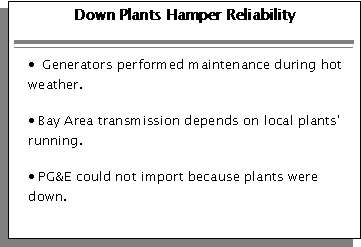 If any of these
plants had been up and operating, the June 14th black-outs might have been
averted. If any of these
plants had been up and operating, the June 14th black-outs might have been
averted.
This summer so far, the power supply system has also been
supplemented by curtailments to "interruptible" customers, generally large industrial customers
that in the aggregate consume more than 3,000 MW of load. Interruptible customers contract
for discounted electricity rates year-round in exchange for agreeing to be interrupted
when power reserves dropped below 5%. This program helps to manage electricity supply in
times of shortage, but the amount of capacity available is limited because relatively few
customers are willing to shut down their industrial processes whenever the electric system
is stressed.
So far this year, the ISO has interrupted power to these customers
when it has called a Stage Two emergency. The interruptions are voluntary, and utility
ratepayers spend over $200 million per year to obtain the right to interrupt certain
customers in times of short supply. The lower rates interruptible customers pay year round
average out to $60,000 to $70,00025per megawatt per year in benefits for interruptible
customers. Large California customers who account for more than 3,000 MW of load are
currently enrolled in the PUC's interruptible programs. Limits on the number of total
hours of interruption prevent interruptible customers from being shut down for
unreasonably long periods, or unreasonably often during the year. For example, PG&E
limits interruptions to no more than 30 per year for any given interruptible customer, and
Southern California Edison limits its program to 25 interruptions per year. The discount
is a cost assumed by California customers for this additional electricity resource.
6. Could the ISO Have Averted Power Outages on June 14?
The question remains whether the ISO might have averted power
outages in the Bay Area. The City of Santa Clara, which operates its own utility, took an
innovative approach to the supply squeeze on June 14. It contacted large customers and
asked them to voluntarily cut back their power so that they would not lose all power. As a
result, the City acquired voluntary load reductions of 7%26-manageable brownouts
instead of blackouts. By taking similar steps, the ISO might have reduced demand enough to
avoid forced blackouts.
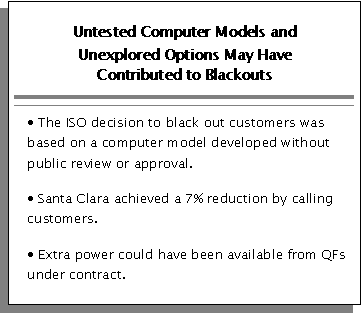 In addition, the ISO made its blackout decisions based on a software program
that has never been subject to public scrutiny or approval. The program's decisionmaking
criteria and assumptions concerning the point at which blackouts must be ordered have
never been validated in a public process or by a public agency. Moreover, the ISO's
computer model required demand reduction received no public scrutiny before its use on
June 14. In addition, the ISO made its blackout decisions based on a software program
that has never been subject to public scrutiny or approval. The program's decisionmaking
criteria and assumptions concerning the point at which blackouts must be ordered have
never been validated in a public process or by a public agency. Moreover, the ISO's
computer model required demand reduction received no public scrutiny before its use on
June 14.
Additional power may be available from QFs that have power
production contracts with utilities, which in turn sell the power into the grid. These
contracts may not currently provide enough financial incentive for QFs to produce power
above minimum contract requirements. The utilities may be able to motivate QFs to produce
more power by committing in advance to a level of payments for additional power when
needed to forestall supply shortages and modulate prices. Some market participants have
estimated informally that such action could free up an additional 500-1000 MW of power
around the state.
Conclusions
California customers have so far this summer endured electricity
outages and, in San Diego, huge increases in their bills as a result of price spikes in
wholesale markets. The extent of the summer's wholesale price spikes cannot be explained
by hot weather, increased natural gas prices, or increases in demand. Other problems -
such as out-of-service power plants, transmission supply constraints and a dysfunctional
power market - may have contributed to the problems so far this summer.
The state's short-term problems appear to evolve at least in part
from past public policy choices regarding electricity supply combined with customer demand
that has grown as a result of the state's robust economy.
III.
Why California's Electric System Is In Trouble
|
The high prices and outages of June 2000 were caused by a number of
events and circumstances:
· New power supplies are inadequate to meet increasing demand
· Existing power plants are aging and in need of attention
· Limited transmission facilities have also contributed to short
supply, especially in San Diego and San Francisco.
· The State has reduced the role of energy efficiency and
construction of renewable energy resources in recent years.
· California's economy has flourished, creating new demand and its
high technology sector is highly dependent on electricity.
· California's electric system is no longer consistently reliable.
The curtailments of power to large customers on June 14 were not
isolated. The ISO has called 10 Stage Two alerts in the past three years.27 Half occurred this
year, with more alerts certain as the summer progresses. The ISO has curtailed power to
more than 1200 of industrial customers since 1998, some customers for more than 20 hours
this year alone. Before 1998, neither SDG&E nor Southern California Edison had ever
interrupted industrial customers. Although PG&E had interrupted industrial customers
prior to restructuring, the frequency of curtailments to its industrial customers has
significantly increased this year. The increase in Stage Two interruptions show that the
electric system's margins are much narrower today than historically.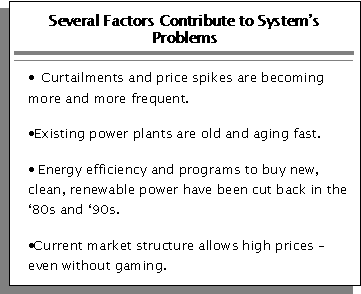
1. California Has Made Only Limited Investments in New
Power Plants in the Past Twenty Years
New power plants are capital-intensive and have long lead times
between planning and completion. Between 1996 and 1999, 672 MW of net generation capacity
was added to California's electric generation capacity, adding less than a 2% capacity
improvement to the approximately 55,500 MW on line.
| |
|
|
Comparison
of Net Generation Capacity Additions and Load Growth,
1996 through 1999 |
| Year |
Net capacity Additions
(MW) |
Growth of Peak
(MW) |
| |
|
|
| 1996 |
462 |
2,376 |
| 1997 |
153 |
2,005 |
| 1998 |
6 |
2,464 |
| 1999 |
51 |
(1,323) |
| Increase |
672 |
5,522 |
| Source: California Energy
Commission |
State and federal regulatory policies have, discouraged new
construction generally, and new investments by utilities in order to encourage others to
build generation and increase competition in generation markets. However, potential
investors in new generation faced uncertainty because of a number of policies and
determinations:
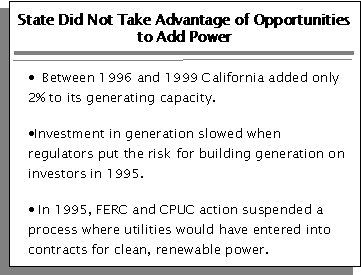
· PUC regulatory ratemaking policy has provided incentives for
utilities to forego new investments and defer maintenance. Specifically,
"performance-based ratemaking" gives utility managers an incentive to save short
term costs to make short term profits and to forego long term investments.
· State regulators in the 1990s abandoned Integrated Resource
Planning - in favor of letting the market decide where and when to build new power plants
and where and when to take energy efficiency measures. As a result, investors assumed most
of the risk of a plant's success or failure. Coordination to ensure adequate electricity
supplies was subject to these market changes.
· The PUC's "Biennial Resource Plan Update" (BRPU) policy
pursued construction of new generation plants by unregulated firms or utility affiliates.
The BRPU required utilities to put their planned new generation out to bid. Prospective
generators submitted bids and began to plan construction, but the PUC ultimately never
approved new plant construction in the BRPU proceeding.
· On February 23, 1995 the PUC's BRPU process was suspended when
FERC ruled that California could not require its utilities to enter into long term
contracts with the renewable power producers. FERC relied on a technical legal principle
that prevented California from requiring utilities to sign contracts that resulted in
rates being set above avoided cost.28
· State and federal tax credits for construction of renewable
resources expired in the 1990s.
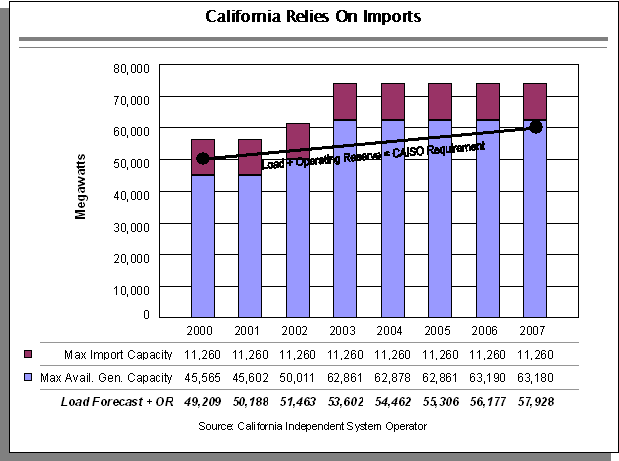
· State siting procedures in California are complex and create
investor risk because of California's commitment to environmental protection and public
participation in the permitting process.
· California's weak economy in the early 1990s may have discouraged
new investments in the State's infrastructure.
· The changing regulatory environment through the 1990s caused
risk-bearing investors to wait until clear rules were established before applying to build
new power plants.
2. California's Demand for More Electricity Has Outstripped
New Supplies
Between 1996 and 1999, California's growing economy caused peak
period demand to increase by over 5,500 MW. The State's population, already the largest in
the country, is increasing by 600,000 people annually. However, new demand for power
increased even faster than the rate of growth in the State's economy.
As the chart below shows, California's demand is expected to grow
faster than new power plants will be built for the next several years.
California-especially Silicon Valley-is the leader of the digital
economy. California ranks first in the nation in the number of high-tech jobs.29 This new technology
economy needs higher quality and more reliable power. Although the new economy's
contribution to increased demand has been debated, clearly a shift in industry sectors
contribute to our society's increasing use of all forms of technology that runs on
electricity, contributes to electricity demand. According to the Electric Power Research
Institute, computers consume about 13% of the nation's power. Another study places the
electricity load attributable to the new economy at 2%.
Whatever the level of electricity required, the effects of the
digital economy on energy requirements will be felt even more strongly over the
next few years, as more individuals and businesses take their commercial transactions
on-line. Over the last three years the amount of information available on the Internet has
increased ten-fold to over one billion discrete pages. Internet use by individuals in 1999
was 80% higher than the previous year. This market has a tremendous potential for
growth-68% of manufacturers report they do not yet conduct purchasing transactions on the
internet. California simply must keep up with the energy needs of high technology, a
highly productive, fast growing segment of California's economy.
Technology firms and, increasingly all businesses, require high
quality, 24 hour power to operate successfully. In the digital economy, power
interruptions are extremely costly. Hewlett Packard reports that a 20-minute outage at a
circuit fabrication plant would result in the loss of a day's production at a cost of $30
million. For purely digital companies, such as Oracle, the price of a power interruption
is "millions of dollars per hour," according to the company's energy director.
Smaller customers' electricity demand is also critical. Customer
demand for electricity appears to be "inelastic" during certain times of the day
and in hot weather30
When demand is inelastic, the need to run air conditioning or maintain a threshold level
of electricity use contributes to the risk of price increases during periods of high
demand, such as hot weather.
3. California Power Plants are Aging and May Need More
Maintenance
California's power plants are aging. The chart below shows that 55%
of the State's generation facilities are more than 30 years old. Older plants need to be
taken out of service for maintenance and repairs more often than more modern plants.
Deregulation of generation may have also motivated owners to run California plants longer
and harder, leading to subsequent reductions in reliability.
 A recent PUC investigation suggests that maintenance problems at some Bay
Area power plants are chronic, and have already resulted in both "forced
outages" (those that occur because of a system problem and cannot be avoided) and
long scheduled downtimes. During June 2000, two of the five power plants surveyed had
forced outages and one was down for scheduled maintenance.31 Moreover, old plants
emit more pollutants than newer more efficient plants in general. Older plants may well
need to schedule additional downtime for environmental retrofits or rehabilitation,
especially to keep in compliance with emissions permits.
A recent PUC investigation suggests that maintenance problems at some Bay
Area power plants are chronic, and have already resulted in both "forced
outages" (those that occur because of a system problem and cannot be avoided) and
long scheduled downtimes. During June 2000, two of the five power plants surveyed had
forced outages and one was down for scheduled maintenance.31 Moreover, old plants
emit more pollutants than newer more efficient plants in general. Older plants may well
need to schedule additional downtime for environmental retrofits or rehabilitation,
especially to keep in compliance with emissions permits.
The PUC's investigation analyzed the status of the power plants
during June 2000, reviewed the plants' work management systems and maintenance programs,
and examined maintenance records, operations logs, plant evaluation and assessment
reports, failure analysis reports, and operations and maintenance manuals.
The review revealed several causes for concern.
· Generation owners decide when to schedule maintenance downtimes;
the downtimes need not be scheduled when they would be least disruptive to the system.
Maintenance was scheduled for June that could have been done before summer, or at least
could have been coordinated with other plants' maintenance to keep a comfortable reserve
available.
· Some maintenance took much longer than expected, increasing the
risk of generation shortage.
· Bay Area power plants are aging, so maintenance problems will
worsen in the coming years. Moreover, when a plant is brought down for one repair, other
problems are discovered. This extends plant downtime. And finding spare parts for
unexpected repairs on an old plant can be time-consuming and difficult in itself.
Over the next few years, many Bay Area power plants will be out of
service for months to address maintenance problems that arise because of plant age.
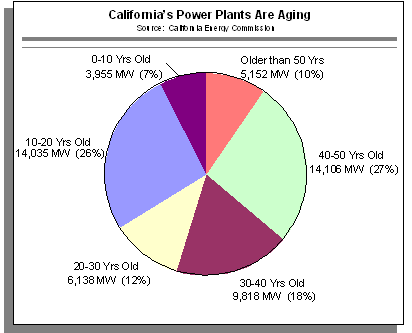 The
time lost to a forced outage is unpredictable. Component failure can cause an outage
lasting less than a day to as long as six months or more, which occurred to a power plant
unit in 1999.32
Scheduled outages for equipment overhaul may take a week or up to four months or more
depending on the extent of the overhaul. The
time lost to a forced outage is unpredictable. Component failure can cause an outage
lasting less than a day to as long as six months or more, which occurred to a power plant
unit in 1999.32
Scheduled outages for equipment overhaul may take a week or up to four months or more
depending on the extent of the overhaul.
4. California Retreated from its Previous Commitments to
Energy Efficiency and Renewable Power.
Historically, California addressed issues of energy supply and
energy demand through an integrated assessment of energy demand and energy resources. The
Warren-Alquist Act of 1974 requires the California Energy Commission to prepare a Biennial
Report that analyzes an integrated supply and demand and provides the basis for a State
energy policy. State energy policy included two elements: a commitment to analysis and
management of electricity demand; and a commitment to resource diversity, recognizing that
reliance on a single fuel source makes the system vulnerable. During the 1980's,
California utilities boasted about having the most diverse mix of energy generation
technologies in the world. 
During the same period, the PUC developed utility-managed energy
efficiency programs, funded through utility rates, which reduced demand and energy usage.
The PUC also aggressively implemented federal policy enacted in 1978 under the Public
Utility Regulatory Policy Act (PURPA).33 PURPA complemented the State's fuel and resource diversity
policy by requiring utilities to contract with "qualifying facilities"-- energy
producers that used renewable resources, such as wind, solar, biomass, and small
hydroelectric generation, or use newer, more-efficient fossil-fuel technologies.
In the 1990s, the PUC's policy shifted away from the emphasis on
renewable power production and strategic energy efficiency. The PUC shifted to funding
energy efficiency programs that encouraged competition between energy service providers
and away from than the specific, high impact, energy reduction programs that had
previously been so successful. The effectiveness of these market-based programs has not
yet been established. For example, existing building standards fall far short of their
maximum energy efficiency potential. The PUC also suspended its program of promoting
renewable resources in the Biennial Resource Plan Update (BRPU) proceeding after the FERC
found technical problems with the way that the PUC set the price utilities would pay for
power. The PUC subsequently moved away from its commitment to renewable energy in favor of
the electric restructuring process that it initiated in 1994 and that lead to AB 1890.
Other agencies followed suit.
In addition, current energy efficiency policy centers on an academic
debate about whether customers will be more responsive to prices with "real
time" or "interval" metering. Theoretically, such meters will educate
consumers as to the changes in electricity price as customers use that electricity.
Economists predict exposure to high electricity prices will cause consumers to manage
consumption, for example, by shifting electricity use to lower cost times of day or
reducing usage in warm seasons.
However the practical aspects of this concept are complex. The full
cost of installing and operating meters especially for residential and small commercial
customers has yet to be calculated with any precision. Edison currently offers
installation of hourly meters that cost about $400 for a small customer plus installation
costs of as high as $228. This meter does not even provide price information customers can
see in real time. It stores information for retrieval (and billing) at a later time. In
order "real time" metering to work, the customer must also know the price of
electricity. Most meters on the market today require the customer to access prices by way
of a separate contemporaneous source, such as the PX Internet site. Investigating the
costs and technology advances that may help drive down those costs is worth exploring, but
the state and costs of metering technology today indicate that customers cannot easily
adjust energy use with metering alone.
Moreover, metering every residential and business customer will not
necessarily change the buying patterns of or provide any benefit to customers who do not
use power during peak periods (for example, those who are at work and school during the
day) or who cannot change buying patterns for reasons of health, comfort, or business
necessity. (Examples include seniors, customers who live in the desert). For those
customers who must use power during high priced periods, switching to real-time pricing
with residential meters installed to identify high priced periods will result in higher
bills, rather than bills calculated using the average prices they pay now. Customers who
cannot afford higher bills, such as seniors on fixed incomes, may compromise their health
and safety trying to avoid them. Metering offers the promise of significant control over
non-essential electricity use. However, technology questions, costs and obsolescence
concerns in this fast changing field caution against statewide immediate metering programs
as the primary tool for customers to bring down retail prices. And energy efficiency
efforts may well be hampered by focussing on undeveloped technology that has such complex
policy implications.
In the AB 1890 negotiations, proponents of renewable energy supplies
and energy efficiency won legislated funding for energy efficiency renewable resources.
However, pursuing a competitive market structure, policy makers made funding for these
programs a low priority. The current funding for these programs is almost 70% less than it
was in the early 1980s. The State's retreat from funding energy efficiency and renewable
energy programs occurred despite the demonstrated economic benefits that energy efficiency
brings to the California economy. RAND, for example, estimates that energy efficiency in
the past 20 years has provided $1000 in economic benefits to each Californian.34
These benefits complement the State's commitment to environmental quality.
5. California's Commitment to Environmental Quality Guides
the State's Supply Options.
The California Environmental Quality Act (CEQA)35and the federal Clean
Air Act36are two
of the principal laws that ensure preservation of public health and environmental quality
when power plants are constructed and operated. These laws focus on the environmental
impacts of California's power choices.
CEQA requires evaluation and mitigation of potential environmental
impacts from a power plant before the State allows construction. In addition to reducing
negative environmental effects caused by any one plant, CEQA could be used to plan
strategically for power plant siting, encourage and streamline construction in key
locations (e.g., to bolster grid reliability) and ensure lower cancer risk and ozone
damage from emissions.
 Failure to conduct adequate environmental review can result in CEQA litigation by
citizens or local government agencies that can delay, change or eliminate a power plant
project.37
Although CEQA exempts emergency measures, the statutory exemption is exceedingly narrow
and only applies to measures taken in response to unexpected catastrophes that threaten
the public. Courts have prevented agencies from using the emergency exemption when those
agencies faced ongoing or existing conditions.38 An attempt to use this exemption to address short-term
reliability risks court action, and it reduces long-term planning for efficient, renewable
power sources.
Failure to conduct adequate environmental review can result in CEQA litigation by
citizens or local government agencies that can delay, change or eliminate a power plant
project.37
Although CEQA exempts emergency measures, the statutory exemption is exceedingly narrow
and only applies to measures taken in response to unexpected catastrophes that threaten
the public. Courts have prevented agencies from using the emergency exemption when those
agencies faced ongoing or existing conditions.38 An attempt to use this exemption to address short-term
reliability risks court action, and it reduces long-term planning for efficient, renewable
power sources.
In addition to CEQA, federal, state and local laws govern air
emissions from power plants. Local Air Districts enforce state, federal, and local air
quality laws for stationary sources.39 Permits for major pollution sources, such as power plants,
involve federal- and state- enforced rules, while small power units are regulated by local
Air District rules that restrict size and limit operational schedules. As a whole, these
rules limit power plants' discharge of cancer-causing or ozone-depleting emissions and
chemicals, and they attempt to increase the efficiency of electricity generation.
Both federal and Air District rules control emissions by requiring
new air emissions sources, including power plants, to have pollution control devices that
meet "Best Available Control Technology" standards and obtain pollution
"offsets" before beginning operation. In addition, existing power plants must
reduce pollution emissions according to pre-set schedules by retrofitting old plants,
adding new controls and/or reducing total emissions in the area by getting
"credit" for reductions from other sources.
The environmental and health benefits obtained by retrofitting
and/or replacing old plants with new ones are large and measurable. For example, two
existing San Diego power plants South Bay and Encina, emit 1100 tons of NOx per year each,40while the new Otay Mesa
plant will emit 90% less NOx per year (100 tons) while producing the same amount of energy
as either of those plants. One of the promises of deregulation was that by building new,
clean plants, California could take old, polluting plants off-line and thereby improve
California's air quality. The failure to build new, clean and efficient capacity as demand
increases means that California is facing even worse air quality because of the need to
keep the old plants. This is exacerbated by the environmental pressure of additional
emergency emissions.
Although the Air Resources Board (ARB) has created new rules to
simplify calculations for air offsets and credits, providing a priority to power plants to
obtain available offsets would require a change in state law. At present, owners of
offsets can sell those offsets to anyone, without regard to the need for future power
plants. In San Diego, the owners of South Bay and Encina power plants control most of the
area's air pollution offsets. They have no incentive to sell them to clean new power plant
competitors.
Health concerns about power plant emissions are real. Preliminary
ARB analysis shows that if all of the diesel emergency generators (approximately 1000) in
San Diego fired up for a single day, it would add 75 tons of NOx to San Diego's air and
increase public exposure to cancer-causing toxics. These emergency generator units have no
emission controls at all. The Bay Area has two to three times as many diesel generators as
San Diego. Increased use of currently installed emergency generator could threaten the
federal Clean Air Act attainment status for the Bay Area. The ARB estimates that one
diesel unit operating for 200 hours will cause 100 new cancers per million people.
Owners of older power plants are put in a tight squeeze between the
ISO rules pushing for additional run times and capacity and environmental requirements
establishing minimum maintenance and retrofit schedules. If these plants stay up and
running for the good of the system as a whole, they risk violating negotiated or required
retrofit schedules. The failure to meet or exceed such schedules reduces the general
availability of emissions credits for those or additional power plants, creating a
spending problem. For example, the time it takes to retrofit old plants can be as short as
a month or as long as three years. Costs vary widely depending on the size of the unit and
the type of pollution controls installed. Most of that retrofitting time is spent
preparing to install the controls; retrofits ordinarily cause plants to be non-operational
for only a few days to a few weeks at a time. Some of the retrofitting rules were designed
to use market incentives to encourage faster retrofits, enabling those who moved ahead of
schedule to sell "credits" to those who were unable to do so. California's power
crunch threatens to delay old power plant environmental retrofits because we need
full-time power production from those plants. At the same time, delays would squeeze the
number of credits available for purchase by plants or other industrial plants that cannot
meet previously established schedules.
One short-term suggestion for relieving immediate power needs is to
use emergency generators more frequently or in advance of Stage 3 emergencies. But this
option creates significant environmental and public health damage. Emergency generators
are old, typically burn diesel fuel and have few if any pollution controls. Air district
permits constrain operation to emergency situations, test intervals, and/or total yearly
operating times; more frequent operation subjects the owners to penalties. Emergency
generators have reported that the ISO ordered them to operate their generators in advance
of declared emergencies and owners of those units have received violation notices from
local air districts for violating their permits.
Using emergency generators caused both a short term and a long term
problem. First, they create significant air quality and health problems when they run.
These problems are exacerbated because hot days where electricity is in short supply are
often also very smoggy days. Second, although investment in pollution controls can reduce
some of the pollution, allowing these generator to run on a periodic or semi-regular
basis, might cause the ISO to absorb and come to rely upon these power sources more
regularly. Instead of investing in cleaner more efficient fuels, dirty old technology
would become part of the power baseline, and it could displace investment in cleaner, more
efficient means.
6. California's Wholesale Electric Market is Flawed
California power markets are not now competitive. The ISO conceded
this in its Market Surveillance Committee's most recent report: "California's energy
and ancillary services markets have not been workably competitive during the last two
summers...(W)e are unable to conclude that California's energy and ancillary services
markets will be workably competitive during high-demand periods this summer."41
The reasons for the lack of competition may be many. The complexity
and fragmentation of power purchase markets may be partly to blame. Their structure may
encourage market participants to game the system to their benefit even while obeying the
rules.
Wholesale electric power has been fragmented into many products,
that are independently priced in a series of auctions administered by the PX and ISO. The
decision to segment wholesale power into four or more separate products creates
significant market inefficiencies that serve to provide gaming opportunities for market
participants, opportunities that may be perfectly available under current rules.
Under the existing design of the system, the ISO cannot consistently
purchase power at the lowest price. In theory, electricity buyers will find the least cost
products; however, they may not have an incentive to do so. This constraint on the ISO
provides another gaming opportunity for power plant operators. Further, the ISO is not
permitted to purchase electricity from the PX when PX products are less expensive than the
products bought and sold in ISO auctions.
Creating further possible problems is the use of "scheduling
coordinators." Scheduling coordinators are the intermediaries between buyers and
sellers and the ISO. Scheduling coordinators coordinate the pricing activities of
generators, other marketers and large consumers to balance supply with demand.
This process may promote collusive activity because Scheduling
coordinator transactions are not necessarily at arms' length. Scheduling coordinator
functions exhibit significant economies of scale and scope, key attributes of a potential
monopolist. As a result, Scheduling coordinators could evolve into large, unregulated
oligopolies that have the opportunity to set the price of power and power products.
Conclusions
California's electricity supplies have not kept pace with the
state's economic growth. Lagging investments in power plants result partly from regulatory
uncertainty and a reliance on competitive markets to assume a comprehensive planning
function that the state had previously performed on behalf of consumers and the state's
economy. As power plants aged, California's economy grew and policy-makers retreated from
aggressive efforts to promote energy efficiency and investments in renewable power
resources. Moreover, the market itself is flawed. This compounds the mismatch between
supply and demand for an essential service.
These circumstances show that electric system governance is just not
working for the benefit of California customers at this time.
V.
Governance of The New Electric Structure Cannot Assure California Gets Reasonably Priced,
Reliable Electricity for California
|
Through the Twentieth Century, inexpensive, reliable electricity was
assured by the close supervision of public agencies responding to public concerns and
answering to the people of California. California's current electricity industry structure
places autonomous, self-governing entities in roles formerly performed by government or
utilities - planning, building, maintaining, and operating generation and transmission,
and setting prices. This decoupling of accountability from control, and the dispersion of
responsibility to market participants and away from government and utilities means that
the events of Summer 2000 could be a permanent feature of the California economy.
Currently, the ISO and the PX have the greatest influence over the
pricing and day-to-day operations of the State's electric system. Yet despite their
enormous authority, the law does not require either the ISO or the PX to act on behalf of
the state's electric consumers or its economy. AB 1890 provides that the PX and the ISO
are accountable to their boards, which are comprised of "stakeholders," shown in
the table below. Although some board members may have ties to consumer groups, they are in
the minority. On the PX Board, only two of 25 current members represent residential
consumer interests. On the ISO Board, only two of 27 current members represent residential
consumer interests.
Many board members are sell power or own generation facilities and
therefore have an interest in keeping prices high. None of them has a duty to serve the
California public interest. The ISO board is also self-perpetuating: it appoints its own
members, subject only to approval by the EOB and the FERC. The ISO is also pursuing a
change in its status to become a regional transmission operator (RTO).
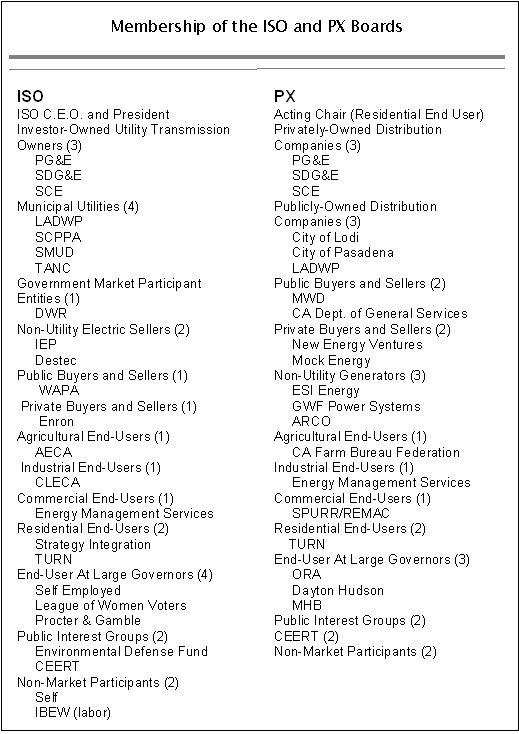
In addition, as private entities, the ISO and PX are not fully
subject to State laws regarding the conduct of their business. These boards conduct some
of their business privately--in executive session-and then assert that they are not
required to report the results of these deliberations.
Although the federal government oversees the ISO and the PX, federal
regulators pursue national interests, not necessarily those of Californians. For example,
the FERC does not incorporate California's strong environmental values into its
decision-making.
FERC's oversight of the ISO and PX is limited in practice partly
because it does not follow a comprehensive model or set of policies. Instead, FERC
generally regulates the ISO and PX by approving or denying tariff proposals. California is
one system among 50 different systems. Therefore, as a practical matter, the FERC probably
cannot provide close supervision of the complex industry structures and the hundreds of
utilities in 50 states, half of whom have created new structures that rely increasingly on
federal action.
Finally, FERC does not have comprehensive oversight of California's
interrelated electric system. Accordingly, it cannot weigh the public policy options that
might be available to affect development of each component part of the
system-transmission, generation, distribution-and the costs and advantages of choosing
among such alternatives as new construction, new rules, new programs or technical
innovations. FERC cannot, for example, choose between the construction of an emergency
peaking plant versus a substation upgrade according to the relative costs and benefits of
each, when markets fail to respond to a need. It cannot address a regional transmission
problem by funding investments in energy efficiency resources even if transmission
facilities are more expensive. While no single agency, state or federal, may be in a
position to regulate all parts of the electric system equally and comprehensively, the
current structure is too fractured to assure California interests are promoted and
protected.
The State needs to reconsider oversight in the following areas:
· Planning for New Generation. The ISO has assumed
increasing responsibility for planning how match supply and demand and transmission system
upgrades in coming years. But the ISO does not set generation prices and is not
accountable to the public for keeping prices reasonable. Energy efficiency, renewable
energy sources, and local concerns like power quality in Silicon Valley need play little
or no part in the ISO's decision-making.
· Reliable Operations. The ISO, which owns no electricity
facilities itself, today runs the transmission system, negotiates with generators to
provide reliability services, and performs virtually all of the non-distribution functions
once performed by utilities. However, the ISO sends no monthly bills to residential
customers, has no phone-bank waiting to receive complaints when the lights go out, and is
accountable only to its board - dominated by market players, not by representatives of the
public interest. The ISO may also find it difficult to coordinate fully with municipal
utilities, some of which own generation and transmission, because the municipal utilities
fear being incorporated into a non-governmental system they don't control.
· Power Plant Maintenance. Just as the ISO is not directly
accountable to the public, the current structure in California breaks the link between
power plant owners and ultimate consumers. For example, neither the ISO nor any State
agency has the authority to direct a generator to continue producing power in an
emergency. For a century, when emergency threatened the reliability of California's
electricity supply, state regulators and utilities had the responsibility and the
authority to take immediate, appropriate action, and were directly accountable to the
people. Today, with aging power plants, California has a structure that puts maintenance
decisions entirely in the hands of power plant owners, whose interests conflict with those
of consumers.
· Pricing. In California today, the price of wholesale
electricity is set by a spot market, not by government or utilities. The price of
electricity is also not necessarily based on power plant costs or even what consumers are
willing to pay. In the PX market, all electricity trades for a single price, a price set
by the highest winning bid, even though other power plant owners are willing to sell their
power at lower prices. This guarantees that customers do not receive the benefits of
competition. This result is built into the California system as an integral part of the
market design. Also, because California has two markets for power - one operated by
the PX in a "day ahead" market and one operated by the ISO in a "real
time" market - generators may withhold power in the PX day ahead market in hopes of
realizing higher prices in the real-time market. During some periods, it is in the
generator's interest to withhold some power because in so doing it can drive prices up,
according to Severin Borenstein, a professor of business at UC Berkeley and PX Board
member. According to Borenstein, restructured electricity markets may have attributes
where "if firms of noticeable size are not exercising market power, they are doing so
out of the goodness of their heart, and against the interest of their shareholders."42 The "ancillary
services" market - the market for things like reserve supplies - may also be
susceptible to gaming.
· Regional Future. The current structure of California's
electricity industry creates risk that the high prices and poor reliability of this summer
will continue for months, perhaps years to come. And despite the inherent problems and the
impacts on California consumers, ISO seeks to expand its control to include not just
California, but neighboring States as well. This would widen even further the gap between
accountability and control. It would also dilute the ISO's concern for the State that
created it.
Conclusions
The operation of California's vast and valuable electric system is
now controlled primarily by the ISO and the PX, organizations that have no duty to serve
California's consumers or economy. The ISO and the PX report to boards that are comprised
of "stakeholders," none of whom represent the public and many of whom have an
interest in keeping wholesale electric prices high. These organizations do not have
contact with the ultimate consumers of power and conduct much of their business in
private.
The pricing system, in combination with inelastic customer demand
and the ability of power sellers to withhold supply, results in wholesale prices that may
bear no relationship to power producers' costs. At the same time, no government body is
compelling power plant construction or maintenance during this period of aging plants and
short supplies.
In sum, power supply shortages, increased demand and a dysfunctional
market are converging to undermine the state's ability to assure its businesses and
citizens have clean, reliable and reasonably priced electricity. California deserves
better.
Solving California's myriad, intertwined energy issues is certain to
be expensive, time-consuming and complex. Despite our best effort, we cannot find
solutions that will work unless we have reliable evidence and accurate comparisons of
costs. We must bear in mind that in the capital-intensive, long lead-time energy industry,
our current crisis cannot be resolved overnight or merely by passing new statutes.
Instead, numerous individual pieces of the energy puzzle must be fitted together to form
the map of California's path electricity sufficiency and reasonable electricity prices.
This summer's blackouts and price spikes were not isolated events,
nor will they be rare unless action is taken. Moreover, San Diego's inadequate energy
infrastructure, combined with the end of the rate freeze, leaves San Diego consumers
bearing the brunt of the flaws in California's energy markets. By January 2002 at the
latest, consumers throughout the State could face the same high prices San Diegans are now
paying.
1. Work Together to Prevent Power Outages In the Next
Twelve Months
Protecting California electricity consumers - both businesses and
households - lies at the heart of the emergency preparedness steps listed in Attachment 2.
We cannot assume that additional power plants will be up and running this year. Thus, we
must try to prevent another black-out through reducing a shifting of electricity demand
during peak use hours.
Many companies have volunteered to reduce their electricity use when
it is really necessary. We applaud their efforts and ask all Californians to join in
conserving electricity usage for the next three months when requested. We reject the
notion that companies must be paid to do the right thing - to reduce load on those days
when electricity reserves become sparse. We welcome other suggestions that enhance
California's ability to prevent blackouts when confronted with localized power plant
outages restricting the availability of generating capacity, or with extremely hot
weather.
Demand side management and load shifting actions form a crucial
component of our ability to avert black-outs. For example, the State may be able to
conserve 1000MW of electricity during peak demand times if the State Water project and its
contractors forego water pumping during specified peak times. While this appears simple on
its face, to enable water pumpers to shift the times of pumping requires equipment,
coordination and an ability to hold water so that pumps can remain idle for short times.
If one water user stops the pumps and the next user downstream cannot do so as well (or
does not know when the upstream user stops) potential problems are obvious. Installing
meters and telemetry equipment to enable water pumpers to be able to defer pumping - and
to coordinate with other users and pumpers - is key to obtaining this statewide load
shifting benefit.
Practical problems arise with this and every conservation or load
shifting measure and will need to be addressed and resolved. Nevertheless, the potential
for savings exists with some innovative thinking and coordinating efforts between the
State and large consumers
Some of the simplest and most effective load shifting can be
accomplished through consumer and commercial education. The Energy Commission estimates
that residential air conditioning accounts for 14% of state-wide electricity demand and
that dryers account for an additional increment. If California households routinely
avoided running their dryers during the times of peak demand (from 2-6 p.m., generally) we
could reduce not only the electricity use from dryers but also the additional air
conditioning burdens created by running the dryer on a hot afternoon. We suggest
investigating and implementing promising, cost effective load shifting programs as soon as
possible.
2. Invest in Smart Energy Use To Tackle Short-Term Scarcity
and Balance Supply & Demand
Because of California's growing economy, the state can expect even
tighter electricity supplies next summer and the summer of 2002. California simply must do
a better job of meeting demand -through reducing both peak load and the base load of
electricity required to run California's economy -- and by providing more electric power
into the system. To the extent power plant construction can be avoided, problems relating
to environmental consequences, and community resistance are avoided. And of course, most
all power plants simply cannot be up and running by next summer. In the immediate term,
the easiest solutions to the lack of supply involve decreasing base and peak demand and
bringing more renewable power on line by the Summer of 2001.
We must compare each supply/efficiency option not against the cost
of a black-out but against the value (costs per megawatt gained) of each available option.
Policymakers should consider an aggressive program of energy efficiency programs and
renewable energy development to ease the shortages projected for next summer.
Much can be done with little visible differences to businesses and
consumers that make huge differences to the demand use bottom line. An extension of the
public goods charge which funds and supports energy efficiency programs, is vital to
continuing the State's energy efficiency and renewable energy programs.
A listing of energy efficiency programs and options is attached as
Attachment 6. We suggest an immediate discussion with policymakers and experts to
determine which programs are the most cost-effective. The environmental effects of each
energy efficiency option should be factored into the equation when determining the value
of each option. Some options can be run by utilities and energy providers; some options
can be pursued on a regional or statewide basis.
The State should also advance its review of current building
standards, which have not been revised for a decade. By building smart from the start,
Californians can reduce the rate by which California's electricity demand increases year
by year. Now is the time to improve our building standards as California's economic boom
fuels new construction throughout California. Moreover, as California grows in warmer
parts of the state, demand for electricity is even higher. Putting into place guidelines
now that help make our buildings as efficient as possible will reduce customers bills and
represent a long-term investment in California's electric supply sufficiency.
Supporting renewable energy sources is also vital for environmental
protection and to assure reliable electric service next summer. The construction of new
large power plants before next summer is unlikely, but California can build additional
renewable energy resources to ease anticipated shortfalls next summer. Attachment 6 lists
renewable options that might be available for Summer 2001, if action is prompt. Of course,
solar and wind options depend upon the sun shining and the wind blowing so those energy
sources are not available 100% of the time. Nonetheless, adding quick, clean, efficient
electricity options to California's basket makes sense and adds to the diversity of energy
sources California needs.
The options listed represent some of the creative and proven methods
that we have reviewed. Although not exhaustive, they are offered to provide a foundation
for further discussion.
3. Improving California's Electricity Supplies is Essential
As outlined above, both the pricing and supply problems Californians
face come down to one simple fact: on some days, not enough electricity can be produced in
California to meet the demand for electricity. Sufficient capacity or demand flexibility
must exist for the very highest demand to be met, whenever that might occur.
Understanding the long lead times that exist for planning and
construction of power plants, many energy companies and utilities are stepping up to the
plate to search for additional generation sources. We suggest that all additional
short-term supply options be identified and put on the table for discussion. If every
option for new supply was built, connected and run, California could have additional power
available, but at an unacceptable cost to rates and to the environment. As a result, the
relative merits and costs of short term supply options must be discussed and analyzed by
policymakers.
Several options suggested to us involve inefficient and
environmentally unfriendly technologies. Other options, especially repowering and
transmission improvements, seem especially promising. But every option has a financial and
environmental cost to it. If capital improvements are made the costs involved in building,
retrofitting, and adding new supply will be added to the rates consumers pay at the time
wholesale power market problems are sending prices skyward. Because of the short supply of
power, if higher polluting generation is added to the supply mix, California will come to
rely on it further degrading the environment and air quality.
If projections are accurate, in five to ten years, California will
have built sufficient electric supplies to power its economy. Over 4,000 megawatts of
additional electricity generation is in the regulatory pipeline today. Almost 3,000 MW of
additional generating capacity have been approved and are under construction. The State
should identify and take appropriate steps to make its regulatory processes as efficient
as possible and to ensure that plants in the planning stages-clean efficient
state-of-the-art plants--are built.
Transmission upgrades in strategic locations cal also improve
reliability. On June 14th the Bay Area experienced black-outs despite the
existence of sufficient power sources existed in other parts of the State. Both the Bay
Area and San Diego have very old transmission systems coupled with very few lines into the
areas. In peak times, those transmission systems are prone to congestion like car traffic
becomes backed up on bridges. If problems occur on three of four lanes of a bridge,
traffic backs up and only a trickle of traffic can make it over the bridge. Allowing
traffic to flow smoothly over all lanes of a bridge, or adding bridges, will reduce
congestion. Adding transmission is a complex and costly endeavor, with perhaps longer
lead-times than plant construction, so we do not address specific proposals here.
Some argue that transmission facilities owned by municipal utilities
need to be integrated into the ISO structure. Municipal utilities built transmission lines
to serve their own customers. The intricacies of combining municipal transmission with
investor-owned utility transmission are perhaps even more complex than building additional
capacity. Moreover, in many if not most instances, contracts exist between the municipal
utilities and the ISO which enable the use of all lines in any event.
We suggest that the immediate focus be placed on upgrading key
transmission infrastructure into constrained regions rather than on arguing about the
particulars of separate systems that are already contractually, economically and
physically linked. Upgrading current transmission infrastructure, especially targeted in
areas that are the most constrained, can help prevent blackouts by allowing available
power to flow to those areas of the State where it is needed.
4. Electricity Pricing Reform is Essential
The events so far this year demonstrate that the mechanism for
pricing electric energy in California is broken and that the state must reclaim some
authority to protect California consumers. The state must address two pricing issues:
pricing authority and pricing philosophy.
Pricing Authority. As a result of restructuring, the FERC
sets prices for the transmission component of the electric bill, in Participating
Transmission Owner rate cases and ISO tariffs. The electric energy component of the bill
is establish by the PUC, but reflects a pure "pass-through" of wholesale
electricity prices. While such a pass-through is required for transactions in wholesale
markets, it may not be required for that portion of electric consumption which is provided
by power plants owned by PUC-jurisdictional utilities, or under long term contracts with
PUC-jurisdictional utilities. The PUC should reconsider whether the wholesale "pass
through" approach to setting the electric energy component of the bill.
The pass through of extremely high wholesale prices constitutes a
critical issue for California. Under federal law, the PUC has little discretion to refuse
to through costs utilities pay for power in wholesale markets. This limitation makes
reform of wholesale markets and wholesale supply relationships absolutely essential.
California must work with the FERC to bring about meaningful reform in the wholesale
market until the supply-demand relationship has eased to the point where competition can
really exist.
In the interim, California should legislate changes in how the
system is governed. We recommend that the boards of the ISO and the PX should be comprised
of members who are appointed by the Governor or other lawmakers, rather than comprised of
"stakeholders." No member should have a conflict of interest. Moreover, the law
should be modified to provide that the duty of the boards is to promote the interests of
the State of California, its consumers and economy. Moreover, ISO deliberations should be
public and the information it has should be available to state agencies for review and
evaluation, consistent with relevant confidentiality protections. The authority of the EOB
to oversee the ISO's
operations and decision-making should also be clarified. State
lawmakers should also consider whether the PUC or the EOB should have authority to
sanction power plant owners, electricity sellers or scheduling coordinators for violations
of the law and rules, rather than requiring the state to initiate lengthy and cumbersome
civil action.
Pricing Philosophy. A substantial proportion of the
electricity consumed in California will come from transactions in wholesale markets. The
philosophy embodied in the restructuring experiment is that individual customer bargain
and sale should establish electricity prices. The PX and ISO wholesale markets exhibit
substantial returns to scale and economies of scope and integration that may make this
philosophy irrelevant. The PUC should explore means whereby customers can aggregate their
loads to levels that would enable them to participate in wholesale power markets where it
is in their interest to do so. In the meantime, the traditional utility obligation to
serve should be clearly understood to require utilities to purchase energy on an
aggregated basis on behalf of their customers with a high degree of diligence and with the
objective of assuring reasonably priced electricity.
Exposing consumers to spot market prices where no market exists or
where the market can be manipulated to the benefit of sellers is both inefficient and
inequitable. Customers who want access to real-time prices should have the opportunity to
obtain metering and other equipment on a voluntary basis. However, the state should not
impose metering on customers for whom metering will mean only much higher bills, primarily
small customers in warm climates.
Customers pay bills that are based on the level of customer usage.
The most effective response to high rates is to reduce usage. Pricing policy should
provide incentives to conserve and the state should fund programs to help customers
conserve.
In addition to providing opportunities for customers to aggregate
load to make electricity purchasing more effective, the PUC should provide businesses with
an array of pricing and service options that enables them to manage the electricity
portion of their cost of doing business, while assuring them the level of service
reliability that meets their respective needs. For business customers, this may entail
calibrating price and level of service much more precisely than has been the practice
under a system of average rates. It should also include programs to evaluate and deploy
site-specific technologies, including generation, which will assist businesses in managing
their electricity usage.
High electric prices are particularly burdensome for low income and
senior customers. The PUC should investigate ways of protecting low income and senior
customers from the immediate effects of high rates and, if high rates persist, reconsider
the discounts offered under the CARE program.
Conclusions
In sum, the state has many options for addressing the current
problems in the electricity industry. We recommend the Governor, state agencies, and the
California legislature work together to assure California's consumers, businesses and
economy get the benefits of clean, safe, reliable electricity, and that the state pursue
problem-solving pragmatically and expeditiously.
NOTES |